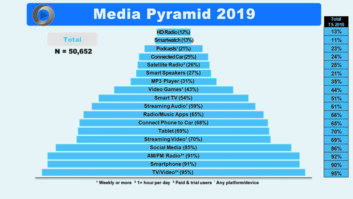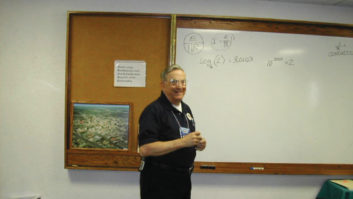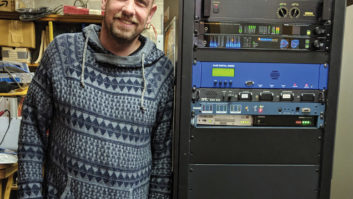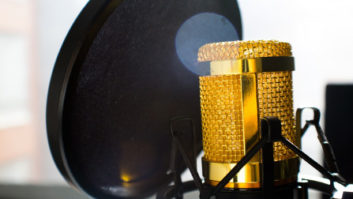The arbitrary boundary of the calendar year provides us with an almost obligatory opportunity to reminisce on the recent past, and look ahead to the near future, on an annual basis.
Far be it for us to avoid this tradition, particularly for 2007, which turned out to be a relatively eventful year for the radio industry.
Probably topping the list was the release of long-anticipated “final rules” for IBOC, with the FCC’s Second Report and Order on DAB, adopted in March (although not effective until Sept. 15).
Among other things, this made it possible for broadcasters to begin FM IBOC multicasting and Extended Hybrid operation without permission or notice. It also allowed AM IBOC broadcasting at night — a topic that has subsequently proven quite controversial, resulting in numerous complaints, the formation of an anti-IBOC coalition, and one radio group’s (Citadel’s) at least temporary cessation of AM IBOC operation. This debate will undoubtedly continue in 2008.
There were other, more positive IBOC-related movements in the industry during 2007, which you may recall from their in-depth coverage on these pages, and which will likely reappear in more real form in 2008.
These include the RadioGuard conditional access (CA) system developed for HD-Radio by NDS and Ibiquity, and the first IBOC receiver chipsets suitable for portable applications. In addition, several industry announcements in 2007 showed promise for the beginnings of a realistic IBOC datacasting business in 2008.
The NRSC did its share of work in the IBOC standardization arena this year, with the release of an informational document on surround sound broadcasting, (the product of an NRSC Working Group that I co-chaired with Steve Fluker, and edited by David Layer of NAB), as well as updates of its AM bandwidth and pre/de-emphasis (NRSC-1-A) and emission mask (NRSC-2-A) standards (to better accommodate IBOC-AM).
It also issued its first “Guidelines” documents delineating recommendations or best practices — one on analog AM bandwidth options (G-100), and another on the harmonization of data between RBDS and IBOC-PSD (G-200).
Less noticed but still important in 2007 was the FCC’s move toward “digital EAS,” with the provisional mandating of the Common Alerting Protocol (CAP) as a new, XML-based method of distributing alert messages among EAS participants.
Meanwhile, NAB introduced its FASTROAD (Flexible Advanced Services for Television and Radio on All Devices) program, a multi-million dollar fund directed toward research, development and incubation of new services that will allow broadcasters’ services to propagate or evolve smoothly into next-gen consumer media systems and the behaviors they engender.
The first fruits of this project may appear in 2008, and they are apparently intended to push the industry beyond its current state, which some might correspondingly describe as the SLOWBOAT (Still Losing Opportunities While Broadcasters’ Old Attitudes Triumph) approach.
The other PPM
One of the most impactful introductions of 2007 may turn out to be Arbitron’s Personal People Meter (PPM, not to be confused with the Peak Program Meter used by audio engineers for audio level display).
The system leverages the same aural masking techniques used by audio compression algorithms to embed audio signatures inaudibly into broadcast content; these are later extracted from recordings made by portable devices worn by selected listeners, thereby indicating their actual radio listening on a given day.
The increased accuracy of listening data caused by the transition from diaries to PPMs for the estimation of audience is likely to have a major effect on the business of radio broadcasting, particularly in the short to mid-term.
Moving from diaries to the PPM literally overnight in any given market is a huge step, though — not unlike exchanging a magnifying glass for an electron microscope — so it will certainly take some getting used to by the industry. This process will be interesting to observe in the coming years.
Lord of the Blings
This year’s title for “Subject on Which Most Rhetoric Was Spewed” undoubtedly goes to radio broadcast performance royalties for music recordings. It’s hard to imagine this issue not winning the same prize next year, as well.
In 2007, most of the discussion focused on Internet radio, due to the periodic (~5 year) review of royalty rates that concluded this year for the period 2006–2010, with substantial increases set by the new Copyright Royalty Board (in its first major action since it was formed by the U.S. Copyright Office).
The decision is still in effective abeyance as the industry continues to discuss its finer points and seek relief, both in Congress and in bilateral discussions with SoundExchange, the royalty collection agency. This process will very likely continue into — and perhaps throughout — 2008.
In CRB Part 2, the board concluded its hearings in October on a similar review of the royalties assessed on satellite radio. At press time, the new rates for that sector were expected to be announced imminently. When they are, it is possible that another reactive firestorm may be ignited (due to another substantial rate hike that is anticipated by many observers), although the far smaller universe of players involved in satellite radio may keep this iteration from burning as long and hard as in the Internet radio case.
But the third part of this epic trilogy could be the real blockbuster: The possible assessment of such royalties on terrestrial radio broadcasting — for the first time. Of course the reaction to this would be nothing short of cataclysmic, and the preparatory rumblings already have begun.
Interestingly, existing law essentially prevents such a change from being unilaterally instituted by the CRB, so it literally requires an act of Congress to do so.
The first proposal for such legislation has been drafted recently by Rep. Howard Berman, D-Calif., chairman of the House Judiciary Committee’s Subcommittee on Courts, the Internet and Intellectual Property, a measure that has already become generally known as “the Berman Bill.”
Should the bill make it into law, it could ultimately lead to new royalties on over-the-air radio broadcasters set by the CRB. Most observers believe a full progression to that end is unlikely, particularly given the strong broadcasting lobby. Yet others have noted that NAB appears more vulnerable than it has been historically, due its still-new leadership, and its concurrent concern with other critical issues, such as media ownership, the ongoing digital TV transition and mobile competition.
Note also that even if such royalties are never assessed on local radio, that industry could still feel an impact from the CRB’s actions via other venues. A direct impact comes from the increased costs on radio broadcasters’ own Internet streams, of course, but there could be an even more important indirect effect.
Consider that the CRB’s imposition of higher costs of operations on Web- and satcasters could cause them to move (or move further) toward an advertising-based business model, and some of the revenue thereby attracted could reduce advertising dollars that might otherwise have been spent on local radio broadcast stations.
It’s one thing to steal listeners, but it’s something else again when advertising revenue is also poached by new competitors. The problem is compounded by the fact there is almost no limit to the number of new entrants that can compete this way other than natural market forces (in other words, there is no scarcity of spectrum or licensing requirement for online competitors).
Increasingly, too, the entire Internet (fueled by its search engines’ success) is drawing more advertising revenues away from traditional media in general. In a PPM world, any such movement — even a small one — could be detected and reported, potentially causing a snowball effect that accelerates the rate of such shifts.
Not a happy scenario for traditional radio, and one that might cause broadcasters to hasten their own exploration of and movement to online alternative services in the next year.
Brother, can you paradigm?
Perhaps the scariest new movement of the year was one that we’ve only seen the beginnings of in 2007, but which may eventually have substantial impact on the radio business.
This was the movement away from DRM-protected music downloads, which is but one part of the entire music industry’s struggle to find a proper business process for the connected entertainment environment. What it specifically implies for radio, however, is that online music stores and subscription services may also ultimately move to an advertising-based business model.
Couple this with the above-mentioned possible transition of Internet radio toward ad support, and it could produce significant erosion of both broadcast-radio listenership and advertising revenues to all of these new media sites.
On the other hand, there are other models that the music industry may move toward other than an ad-supported one, and several of those also made their debut in 2007. Most notable was Radiohead’s pay-what-you-like download (or buy the CD with some extras) experiment, the ultimate outcome of which is still in question.
Finally, no year-in-review article is complete without a “What’s In and What’s Out” list, which we present here for your review, along with our best wishes for you and your business in 2008!
(click thumbnail)













